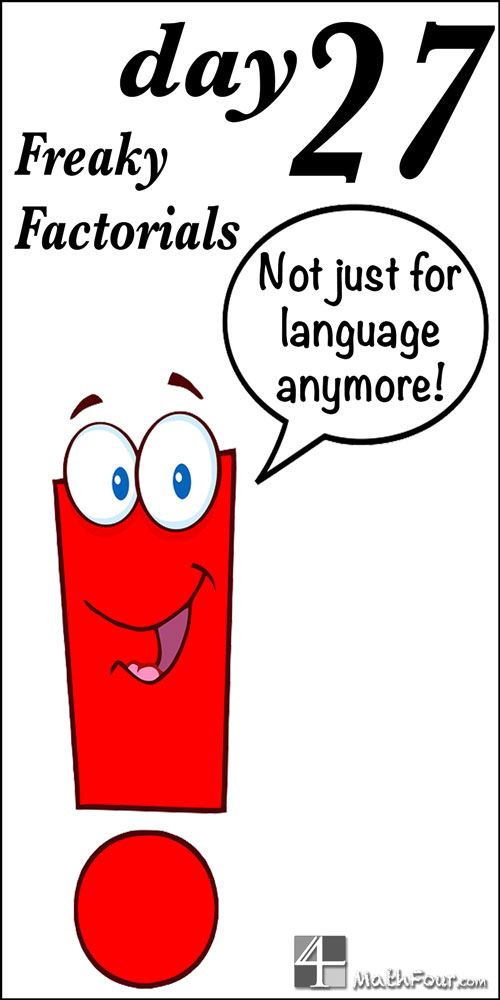This is Day 27 of 31 Days of Math Learning Success. Follow all the days here and check out others that are writing for 31 days here.
 Writers have borrowed from the Germans the abbreviation
Writers have borrowed from the Germans the abbreviation ![]() … which gives their pages the appearance of expressing surprise and admiration that 2, 3, 4,etc. should be found in mathematical results.
… which gives their pages the appearance of expressing surprise and admiration that 2, 3, 4,etc. should be found in mathematical results.
~Augustus De Morgan
At some point in your math life, you’ll encounter the f-word.
And by that I don’t mean fractions or functions.
I mean factorials.
Like many other math things, these guys aren’t bad to deal with if you remember what they really are. And you aren’t afraid to get your hands a little dirty.
What is a factorial?
A factorial is a unary operation on a non-negative integer. If the integer is positive, it returns the product of all integers from 1 to that number. If the integer is Zero, it returns 1.
Holy cow… that’s all true, but impossible to understand.
How about this:
A factorial is an instruction. It says to a positive number: “Multiply yourself with all the other numbers less that you.”
It says to Zero, “Give me a 1. Don’t think about it. Just give me a 1.”
And it doesn’t give any instructions to negatives or fractions/decimals or any other crazy number-like-things. (It pretty much ignores them and refuses to work at all.)
We say something like “six factorial” when we mean ![]() .
.
And since writing out “6 factorial” takes a while, we write 6! instead.
Six Dammit
My favorite professor would sometimes jokingly refer to the exclamation point as an actual point of exclamation. When we were doing 6!, he would say, “Now we do six dammit.”
And that’s a bit what students might say when dealing with these.
As a math student, you’ll likely encounter factorials in a probability course. Which means you’ll be faced with this expression: ![]() .
.
And you’ll be mighty tempted to reduce the fraction by cancelling out: ![]() .
.
But be careful. Look closely at what these guys mean. And note that factorials fall into “isolation” in the order of operations.
![]()
And 120 is not the same as 2!, for sure!
Freaky Factorial Facts
If you’re careful about that, you should be fine. But factorials are so freaky, that it’s worth noting some of their more interesting facts:
If you have the phone number 362-8800, your phone number is 10!. (I’m dying to call people and tell them this. So far my frontal lobe is doing a great job helping me inhibit these impulses.)
As of right now, the phone number that corresponds to 13! does not exist. Go ahead, call it: 622-702-0800. (Turns out 622 as an area code isn’t used. Yet.)
90! is the largest factorial you can tweet (it has 139 digits). And you can tweet me on that!
200! has 375 digits. This is the same number of characters in the first paragraph of Pride & Prejudice by Jane Austen. The preamble to the U.S. Constitution is much shorter – it has only 327 characters!
Use Factorials Carefully
Now that you know more about them, you might check yourself before writing something like: “My daughter is turning 4!”
Don’t make her grow up too soon!
Are you enjoying the 31 Days of Math Learning Success? Share it on Twitter, Facebook and Pinterest!
This post may contain affiliate links. When you use them, you support us so we can continue to provide free content!








Sorry, comments are closed for this post.